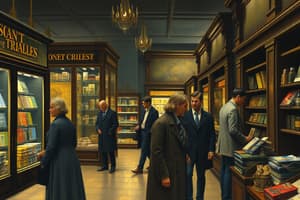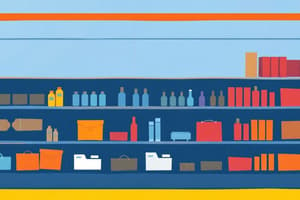Podcast
Questions and Answers
What are the four types of consumer utilities offered by retailers?
What are the four types of consumer utilities offered by retailers?
- Time, place, form, and possession (correct)
- Location, convenience, choice, and time
- Quality, service, price, and variety
- Design, quality, support, and finance
Which of the following best describes 'merchant wholesalers'?
Which of the following best describes 'merchant wholesalers'?
- Facilitators of sales who do not take title
- Wholesalers who import goods from other countries
- Retailers who take title to merchandise (correct)
- Entities that only offer financial services
What does the 'Retail Life Cycle' represent?
What does the 'Retail Life Cycle' represent?
- The relationship between retail price and demand
- The stages of product development in retail
- The evolution of retail strategies over time
- Stages of growth and decline for retail outlets (correct)
Which of the following is NOT a form of nonstore retailing?
Which of the following is NOT a form of nonstore retailing?
What type of service do full-service retailers typically provide?
What type of service do full-service retailers typically provide?
How are retail outlets primarily classified?
How are retail outlets primarily classified?
What is a key characteristic of off-price retailing?
What is a key characteristic of off-price retailing?
Which strategy focuses on managing merchandise assortment for sales/profit?
Which strategy focuses on managing merchandise assortment for sales/profit?
What does the 'Wheel of Retailing' describe?
What does the 'Wheel of Retailing' describe?
Which retail pricing strategy focuses on maintaining low prices regardless of demand?
Which retail pricing strategy focuses on maintaining low prices regardless of demand?
Flashcards
Retailing
Retailing
Activities involved in selling, renting, or providing products and services directly to consumers.
Consumer Utilities
Consumer Utilities
Utilities that retailers provide to make products more convenient for consumers, including:
- Place utility (availability at convenient locations)
- Time utility (availability when needed)
- Form utility (products customized to specific needs)
- Possession utility (easy access to financing or trade-ins)
Forms of Ownership
Forms of Ownership
Different ways retailers are organized, including:
- Independent retailers (owned by an individual or family)
- Corporate chains (multiple stores owned by a company)
- Contractual systems (franchise or co-op arrangements)
Level of Service
Level of Service
Signup and view all the flashcards
Merchandise Line
Merchandise Line
Signup and view all the flashcards
Category Management
Category Management
Signup and view all the flashcards
Off-Price Retailing
Off-Price Retailing
Signup and view all the flashcards
Nonstore Retailing
Nonstore Retailing
Signup and view all the flashcards
Wheel of Retailing
Wheel of Retailing
Signup and view all the flashcards
Retail Life Cycle
Retail Life Cycle
Signup and view all the flashcards
Study Notes
Retailing Key Concepts
- Retailing Defined: Activities around selling, renting, or providing products/services to final consumers.
- Consumer Utilities: Retailers create place, possession, form, and time utility for customers.
- Ownership Forms: Retailers are classified as independent stores, corporate chains, or contractual systems.
- Service Levels: Retailers offer self-service, limited service, or full service.
- Merchandise Lines: Retailers vary in the depth (assortment) and breadth (variety) of products offered.
- Category Management: A method for managing merchandise to enhance sales and profits.
- Off-Price Retailing: Selling brand-name goods at reduced prices.
- Nonstore Retailing: Includes vending machines, catalogs, TV shopping, online sales, and direct selling.
Retailing Value and Utilities
- Economic Value: Retailing provides jobs and retail sales volume representing economic value.
- Place Utility: Examples include ATMs, branch offices providing products at convenient location
- Time Utility: Providing products like out-of-season equipment, meeting customer demand at the desired time
- Form Utility: Customization services (e.g., personalizing clothing), changing the product form to meet a specific need
- Possession Utility: Assistance with financing, trade-ins, and making purchasing easier
Classifying Retail Outlets
- Ownership: Independent retailers, corporate chains, and contractual business model systems
- Service Levels: Self-service, limited service, and full service.
- Merchandise Line: Product variety, offering a wide breadth (types) and depth (assortment) of goods
Formulating a Retailing Strategy
- Retail Pricing: Decisions based on demand, cost, profit, and competitor pricing.
- Store Location: Choosing the optimal location and number of stores.
- Retail Communication: Establishing a store image, and targeting shoppers.
- Merchandise Management: Managing product lines based on breadth and depth, and utilizing category management.
Evolution of Retailing
- Wheel of Retailing: Describes the progression of new retailers entering the market.
- Retail Life Cycle: Stages of growth from early stages of development, through maturity to eventual decline: growth, acceleration, maturity, decline.
Wholesaling Functions
- Merchant Wholesalers: Take ownership of the goods they resell.
- Agents/Brokers: Facilitate sales without taking title (ownership) to the goods.
Studying That Suits You
Use AI to generate personalized quizzes and flashcards to suit your learning preferences.




